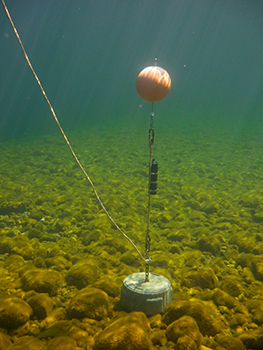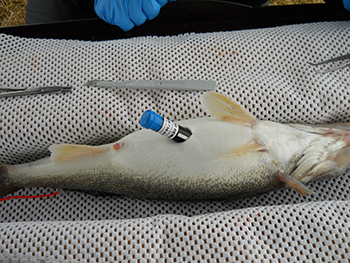‘Oh, the places they’ll go’ – acoustic telemetry helps unveil fish movements, better manage Michigan’s fisheries
By TODD WILLS, SETH HERBST, DAVID FIELDER, JAN-MICHAEL HESSENAUER, BEN TURSHAK and CHRIS VANDERGOOT*
Michigan Department of Natural Resources Fisheries Division staff members and *director of the Great Lakes Acoustic Telemetry Observation System
We all know fish swim and move. But the when, where and why often remains a mystery for anglers and fisheries managers alike.
Managing fish populations requires a comprehensive understanding of fish behavior – driven by the biology of the fish and the environments they live in – as well as the anglers who value and enjoy Michigan’s world-class fisheries. Understanding angler behavior is relatively easy because people talk and can tell us what they like to catch and what motivates them to fish. Fish behavior, on the other hand? Well, that is more of a challenge.
The animals we are passionate about, both as anglers and resource managers, aren’t vocal and remain hidden in the depths of Michigan’s waters, where their movements are mostly unseen. Fortunately, fisheries managers in Michigan have adopted an advanced technology to unravel the mysteries of when, where, why and even how far fish travel. That technology is acoustic telemetry, and the information gained from this high-tech tracking method is helping fisheries managers address a variety of challenges, including conserving native stocks, controlling invasive species and understanding habitat use.
Great Lakes Acoustic Telemetry Observation System network

Deciphering fish movement patterns in the Great Lakes with acoustic telemetry became much easier in 2010, with the creation of the Great Lakes Acoustic Telemetry Observations System. The GLATOS network uses cutting-edge technology to repeatedly observe the location of individual fish across short time intervals.
The ability to record the location of an individual fish over time is a substantial advancement from previous methods that solely relied upon knowing the release location of a uniquely marked fish and a subsequent recapture location, often provided by an angler. While the data from these methods are informative, a major shortcoming is that they provide no information on how the fish behaves between the time it was released and recaptured.
So how does acoustic telemetry work? The GLATOS network functions as a surveillance grid, consisting of receivers, or “listening stations,” strategically placed throughout the Great Lakes and capable of recording detections of fish that have been implanted with individually coded acoustic transmitters – or “pingers” – that the receivers are constantly listening for. This network of receivers and pinging fish provides vast spatial coverage of some of the largest lakes in the world and is supported by intensive collaborations among several state, federal and tribal fisheries resources agencies, universities and nongovernmental organizations.
There are currently more than 3,000 receivers in the Great Lakes Basin in the process of detecting pinging fish. An astonishing 24,000 fish have been implanted with acoustic transmitters since the GLATOS network was created, providing fisheries managers with year-round, 24/7, fine-scale fish behavior data that was never available before.
Read on for a snapshot of what biologists have learned about some of Michigan’s most popular fish species, starting in Lake Michigan and taking a clockwise trip around The Mitten.
Lake Michigan whitefish
|

Lake whitefish yields in Lake Michigan and Lake Huron have declined by more than 50% since the early 2000s. Although the reasons for these declines remain somewhat unclear, the lasting effects of invasive species on Great Lakes habitat and food webs are certainly at play. For example, the smothering of rocky spawning reefs by invasive zebra and quagga mussels may be reducing lake whitefish egg deposition and survival.
As part of an effort to ultimately restore this lost reef habitat, researchers from the Michigan Department of Natural Resources and other agencies are using acoustic telemetry to characterize fine-scale movement patterns of lake whitefish on several reefs in northern Lake Michigan during the fall spawning season. Many acoustic receivers are placed closely together over the spawning reefs to precisely determine the position of acoustic-tagged fish and their spawning locations. Pairing these positional data with high-resolution maps of the water depths and lake bottom around the reefs allows researchers to examine the habitat characteristics that concentrate lake whitefish during the spawning season.
These data indicate that shallow reef complexes have “hot spots” for spawning activity that often correspond with shallow, low-sloping, rocky ridges. The collection of eggs on these hot spots has affirmed that acoustic telemetry data can be used to correctly identify spawning locations where egg deposition is occurring. Researchers are now using these high-resolution data to prioritize experimental invasive mussel removal efforts on spawning reefs to locally increase egg deposition and survival.
Saginaw Bay walleye
|

Decades-long jaw tagging experiments have shown that some walleye leave Saginaw Bay for the main basin of Lake Huron, but before the GLATOS network was available, little was known about the actual proportion, timing and range of their movement. Acoustic telemetry led to the discovery that nearly 40% of Saginaw Bay’s walleye migrate into the main basin by June 1 each year, with no movement out of the bay later in the year. The fish that leave Saginaw Bay travel long distances and repeatedly go to the same destinations each year before returning in the fall to overwinter and spawn again the following spring.
Researchers aren’t sure why some walleye migrate and others remain residents of the bay, but whichever behavior they exhibit is consistent each year. These details about fish movement are very important for stock assessment and for setting fishing regulations, because they help managers understand when and where fish will be susceptible to angler harvest.
More recently, acoustic telemetry is being used to learn where walleye are spawning in Saginaw Bay and how these spawning fish use the different rivers and reefs in the bay. This work will help fisheries managers know which spawning locations are the most important to protect and perhaps pursue improvements to fish passage in rivers or restore reef habitat.
Muskie and smallmouth bass in the Lake St. Clair-Detroit River system
|

The muskellunge and smallmouth bass fisheries in Lake St. Clair and its connecting waters are world-famous and renowned for their high catch rates. The Michigan DNR and its partners have been using the GLATOS network to better understand the behavior of these two species that are the target of substantial angler effort in southeast Michigan.
Acoustic telemetry revealed widespread movements of muskie throughout Lake St. Clair, the Detroit River and Lake Erie, including the movement of one fish from its tagging location in the Detroit River all the way to Buffalo, New York, and back! Movements like this demonstrate the potential connectivity of Great Lakes muskellunge populations, the movement potential of individual fish, and the importance of collaborative and well-coordinated interagency fisheries management for populations that cross state and provincial borders.
Meanwhile, investigations of smallmouth bass in Lake St. Clair demonstrate that they tend to remain in relatively confined areas within the lake, like Anchor Bay in the northern part of the lake or the Mile roads on the western shoreline, despite frequent movements within those areas. This behavior suggests that the Lake St. Clair smallmouth bass population could be comprised of different subpopulations of fish, which may have their own demographics. The characteristics of these unique subpopulations must be accounted for when managing the lake as a whole.
Can anglers assist with acoustic telemetry research?
Yes! Anglers can and do provide a great deal of help with ongoing acoustic telemetry studies in the Great Lakes. Many of the fish that are currently pinging have external tags on their bodies that indicate an acoustic transmitter is implanted inside. When anglers catch one of these fish, they should call the phone number on the external tag or visit the Michigan DNR Eyes in the Field online reporting system to tell us, making sure to record the details on the external tag, including the tag number, prior to reporting. If the fish is harvested, the DNR can make arrangements to collect the acoustic transmitter, which can sometimes be reused in another fish. When a fish with an acoustic tag is captured by an angler and released, reporting the capture location helps biologists to confirm the fish is alive and verify its location.
If you’re interested in learning more about fish and the places they go, be sure to visit the GLATOS website for a variety of news articles and scientific publications highlighting the results of this important work throughout the Great Lakes Basin.
|
Check out previous Showcasing the DNR stories in our archive at Michigan.gov/DNRStories. To subscribe to upcoming Showcasing articles, sign up for free email delivery at Michigan.gov/DNREmail.
Note to editors: Contact: John Pepin, Showcasing the DNR series editor, 906-226-1352. Accompanying photos and a text-only version of this story are available below for download. Caption information follows. Credit Michigan Department of Natural Resources, unless otherwise noted.
Text-only version of this story.
Bass: A smallmouth bass with a freshly implanted acoustic transmitter and external anchor tag, extending from the fish’s stomach.
Implanting: Michigan Department of Natural Resources fisheries research biologist Jan-Michael Hessenauer surgically implants an acoustic transmitter into a smallmouth bass.
Muskellunge: Michigan Department of Natural Resources fisheries research technician Brad Utrup prepares to release an acoustically tagged muskellunge on Lake St. Clair.
Receiver: An acoustic receiver anchored underwater. More than 3,000 receivers in the Great Lakes Basin are currently in the process of detecting signals from fish implanted with individually coded acoustic transmitters. (Photo credit: T. Binder, Great Lakes Fishery Commission via GLATOS)
Transmitter: An acoustic transmitter being implanted into a walleye. After the transmitter is implanted, the body cavity is surgically sutured prior to releasing the fish into the water.
|